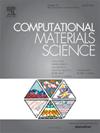Computational insights into surface dynamics, Mg clustering, and dendrite formation in magnesium batteries
IF 3.1
3区 材料科学
Q2 MATERIALS SCIENCE, MULTIDISCIPLINARY
引用次数: 0
Abstract
This study sheds light on the surface dynamics of a MgTFSI-Cl/DME-based electrolyte solution and a pristine Mg(0001) surface, employing density functional theory (DFT) simulations to characterize the surface area and isosurface of magnesium under varying temperature and salt concentration conditions. A primary focus is understanding how these surface dynamics and factors help us understand the precursor mechanisms and structures leading to dendrite formation in magnesium batteries. The simulations reveal that the combination of high salt concentration and temperature leads to excessive surface areas, deviating from the ideal ‘Goldilocks morphology’, and can cause the isosurface to shift away from the anode’s surface. This displacement can create a concentration gradient conducive to Mg clustering, a precursor to dendrite formation. The simulations provide critical insights into the complex interplay between surface area, isosurface characteristics, and the operational parameters of magnesium anodes. The results underscore the importance of optimizing these factors to mitigate dendrite formation, offering valuable guidance for developing more efficient and safer magnesium-ion batteries (MiBs). This study enhances our understanding of the fundamental processes governing dendrite formation and proposes a novel approach to addressing one of the key challenges in advancing magnesium battery technology.

求助全文
约1分钟内获得全文
求助全文
来源期刊

Computational Materials Science
工程技术-材料科学:综合
CiteScore
6.50
自引率
6.10%
发文量
665
审稿时长
26 days
期刊介绍:
The goal of Computational Materials Science is to report on results that provide new or unique insights into, or significantly expand our understanding of, the properties of materials or phenomena associated with their design, synthesis, processing, characterization, and utilization. To be relevant to the journal, the results should be applied or applicable to specific material systems that are discussed within the submission.
 求助内容:
求助内容: 应助结果提醒方式:
应助结果提醒方式:


